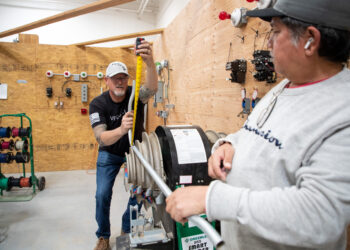
Culinary careers are sizzling again as the hospitality and restaurant industry bounces back from the pandemic and seeks to fill the positions vacated during the COVID-19 downturn. Chaffey College is doing its part to get more cooks in the kitchen.

Logistics technicians are in short supply… but there’s no time to appreciate the irony.
While unemployment soared in most sectors during the pandemic, logistics actually climbed by a whopping 12 percent in Riverside and San Bernardino counties last April, according to the Press-Enterprise. Now, nearly one in eight of all Inland Empire employees work in the sector.
This surging demand is why San Bernardino Valley College can’t afford to miss a beat when it comes to training the region’s in-demand automation professionals. These pandemic-era superheroes are essential to keeping the logistics of “big-box” warehouses running smoothly… but employers are having trouble keeping them in stock.
“These techs are in such demand — there are so many warehouses that are springing up because of online purchasing,” explains Tarif “Terry” Halabi, Chairman of Electricity/Electronics Technology at SBVC. The department’s mechatronics classes teach critical industrial automation skills to keep conveyor belts moving.
As the professor says, “There will always be a need for these kinds of students.”
Last year, the College shifted to industrial automation simulators in mechatronics courses to overcome training disruptions arising from the pivot to online learning. The bold move meant students could keep up with their studies and continue landing above-entry-level careers in the industry — even amid the tumult of 2020.
Last year, for example, at least four grads became Electronic Systems Technician Level 2 with Amazon, joining three other alums already working on such systems. According to Halabi, Tech 2 employees earn $25 an hour with full benefits, with paychecks increasing to $33 an hour when they progress to Tech 3. Grads were also snapped up by Walmart and many others.
Logistics students start high on the career ladder… and they never stop climbing. According to the instructor, learners go on to positions in general maintenance, management, and can even graduate to “running the whole plant.”
As the shift to distance learning threatened to hamper the talent pipeline, the College deployed a secret weapon: cutting-edge simulation software by LabVolt.
“LabVolt is a huge trainer manufacturing company for educational systems, which basically simulate everything that’s out in industry,” explains Halabi. Initially, the instructor wasn’t convinced that the simulators could pass muster, as mechatronics classes traditionally engage hands-on with authentic industrial equipment.
“We had to go back and figure out how we were going to teach our curriculum,” recalls the chairman. When it came to trying out the simulators, he says, “We had no choice.”
But like so many instructors who bravely forged ahead during the unprecedented disruption, Halabi found a surprising silver lining.
“They basically simulated [the equipment] so well that you could do 85 percent of the class without having the system there,” beams the instructor. “They really came in handy, so it worked out well.”
The simulation trainers present the same small-scale systems that Amazon and other industry giants use in their warehousing and distribution centers. To get a full understanding of what the trainers reproduce, Halabi suggests considering the entire warehouse journey: “Let’s say a box comes in on conveyor belts. It’s moved down the line, and it can be shipped, shelved, stacked, and retrieved — all automatically.”
Automated systems save companies a tremendous amount of time as items are imaged, sorted, measured, and recorded at lightning speed. That’s why mechatronic skills are crucial for sorting and shipping goods within mere minutes, making good on the 24-hour Prime delivery promise, in Amazon’s case.
SBVC students learn the core skills to help manufacturers mass-produce and distribute, allowing them to save on labor costs and operate more efficiently. From barcode readers to temperature modulators, the school’s new software emulated the same industrial controls for pneumatics, fluid hydraulics and sensors.
In fact, the simulation trainers were so successful that the College continues to include the virtual tech even after classes returned to campus. According to Halabi, the software helps streamline the troubleshooting process.
“Let’s say that the system fails,” posits the professor. “We can use the software, indicate what caused the system to fail, then solve it using the simulation software. When [students] come into the lab, they can actually implement that on the physical trainer.”
Using the simulation software in conjunction with the actual equipment gives learners a deeper understanding of the material and an extra tool. According to the professor, students “really love it.”
Those troubleshooting skills often come in handy in the field.
“Every system goes down,” explains Halabi. Whether it’s a bad connection, sensor or motor, glitches can come from anywhere. “We teach them how to look out for any of these situations because they are going to be maintaining these systems.
“You can’t afford to have them go down.”
Unplanned downtime can cost companies anywhere from thousands to more than a million dollars per hour, according to the automation company Avantra.
That’s why mechatronic skills are so important in the industry — and why they are fundamental courses in both the General Electric and Industrial Automation programs at SBVC. Halabi says that employers will often call him, desperate to find students who can work on PLC (programmable logic controller) automated conveyor belt systems. The instructor always has the same answer.
“We tell them, ‘Yeah! This is what our program is geared for.’”
Students are hired far and wide in the region, including the mega Walmart distribution center in Colton that opened in 2019.
“I had two students who placed with them because they all use the same type of automation shelving and distribution system for logistics,” beams the proud professor.
The Inland Empire has increasingly become the epicenter for logistics and transportation warehouses. In 2019, the region housed 21 of the nation’s 100 biggest logistics leases, comprising 17.5 million square feet, according to the California attorney general’s office.
Meanwhile, the need for warehouses and workers has only increased since the pandemic, as demand for online shopping — and the warehouses to store those goods — continues to grow. Currently, there are more than 700 big-box warehouses in Inland Empire, with more on the way.
“We have a huge demand for students,” says the professor, who is proud that the pandemic couldn’t stop the regional talent pipeline. “Our students come out of these automation programs ready to work for any of these distribution centers.”
Sources
The hidden costs of downtime, Avantra, https://www.avantra.com/blog/the-hidden-costs-of-sap-downtime
Number of big-box buildings in Inland Empire, California from 2009 to 2020, Statista, https://www.statista.com/statistics/757252/number-of-big-box-buildings-inland-empire/
Pandemic drove logistics jobs up to 12% in Riverside, San Bernardino counties, The Press-Enterprise, https://www.pe.com/2021/04/01/pandemic-made-logistics-12-of-jobs-in-riverside-and-san-bernardino-counties/
Warehouse Projects: Best Practices and Mitigation Measures to Comply with the California Environmental Quality Act, State of California Department of Justice, https://oag.ca.gov/sites/all/files/agweb/pdfs/environment/warehouse-best-practices.pdf
The Quest to Green an Empire of Mega-Warehouses, Bloomberg CityLab, https://www.bloomberg.com/news/articles/2021-06-14/california-launches-new-war-on-warehouse-pollution

Culinary careers are sizzling again as the hospitality and restaurant industry bounces back from the pandemic and seeks to fill the positions vacated during the COVID-19 downturn. Chaffey College is doing its part to get more cooks in the kitchen.

Dual Enrollment (DE) is catching on as students and their families recognize the advantages of earning college credit while still working towards high school graduation. But students aren’t the only… Read More – Good News for Community Colleges: Dual Enrollments Are on the Rise

Enrollment in courses not offering credit toward a degree or certificate are outpacing for-credit programs in some states (Fed Communities). And it’s no wonder. With the convenience, minimal time commitment,… Read More – No Credit, No Problem: Noncredit Courses Gain Steam